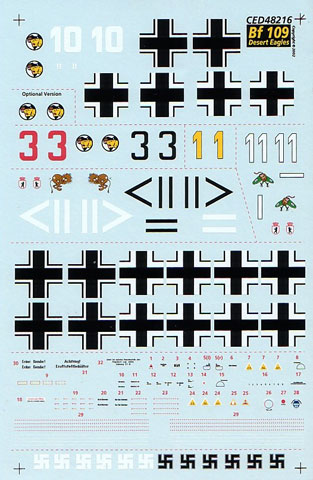|
S u m m a r y
|
| Catalogue
Number: |
CED48216 Bf 109 E/F
Desert Eagles |
| Scale: |
1/48 |
| Contents and Media: |
Double-sided full colour
letter-sized instructions plus notes sheet; 1 x full-size decal
sheet. |
| Price: |
USD$9.99 from
Meteor Productions website |
| Review Type: |
FirstLook |
| Advantages: |
Thin carrier film, perfect
registration, some stencil data included. |
| Disadvantages: |
Stencil data instructions
supplied for a G-6 |
| Recommendation: |
Recommended |
Reviewed by Rob Baumgartner

HyperScale is proudly sponsored by Meteor
Productions
This latest release from Cutting Edge concentrates on those Bf 109s that
flew with JG 27 in North Africa. The chosen aircraft are colourful and
varied with both the E and F models represented.
The aircraft depicted are:
 “White
11”, Bf 109 F-2/Z Trop, II/JG 27, North Africa, 1941. “White
11”, Bf 109 F-2/Z Trop, II/JG 27, North Africa, 1941.
Although the reference source used by Cutting Edge claims this as a F-2/Z,
it is believed that no F-2 machines were fitted with the GM-1 nitrous
oxide boosting.
The aircraft displays the usual desert paints of RLM 79 Tan upper surfaces
over the RLM 78 Blue fuselage sides. The lower engine cowl is given as
yellow and a white theatre band surrounds the fuselage.
The engine cowl wears the Berlin bear shield of II./JG 27 with the “winged
lion” emblem of 4./JG 27 below the cockpit.
“Black 3”, Bf 109 E-4 Trop, JG 27, Libya 1941.
This is a very popular Emil due to its rather patchy colour scheme.
A “front on” photo seen in another publication shows what looks like a
centerline rack and hence they named this a Bf 109 E-7 Trop from 2./JG27.
The same pic also reveals a white painted segment to the spinner.
The original caouflage was upper surfaces of RLM 71 Dark Green and RLM 02
Green-Grey over RLM 65 Light Blue under surfaces. A previous fuselage
number has been over painted in RLM 02 and a stripped pattern in RLM 71
was applied.
The badge of I./JG27 appeared in the usual position on the engine cowl and
the fuselage number was black outlined in red. The ever-present white
fuselage band is also seen.
“< II”, Bf 109 F-4 Trop, Stab II./JG 27, Libya, March 1941.
Flown by Ofw. Otto Schultz.
At this time, Otto Schultz was not a member of the Gruppenstab so this was
not his aircraft. In March he was flying “White 2” and it was only when he
was promoted to Oberleutnant in May that he joined the Gruppenstab. The
captioning mistake coming about due to Schultz posing for the photographer
in this machine.
The aircraft carries the badge of II./JG 27 on the nose and the Stab
II./JG27 lion under the cockpit. Normal camouflage of RLM 79 Tan on the
upper surfaces over RLM 78 Blue are seen with a yellow nose and white wing
tips.
“White 10”, Bf 109 E-7 Trop, 1./JG 27, Libya, August 1941.
Flown by Fw. Günther Steinhausen.
Upper surfaces are finished in RLM 79 over RLM 78 under surfaces. Large
patches of RLM 80 Olive Green are seen on the fuselage sides. The aircraft
features a completely painted yellow nose and rudder with the white
theatre band around the fuselage.
A fine in flight shot of “white 10” in the reference below, reveals that
this same aircraft can be finished in a different scheme from that
portrayed by Cutting Edge. Here we see the aircraft with 3 white victory
bars on the tail. Although not shown on the instruction sheet, Cutting
Edge supplies four of these markings. It should also be noted that the
Unit badge is positioned a lot further forward than usual and the RLM 80
mottle goes further down the fuselage side.
"Yellow 1”, Bf 109 F-4 Trop, 3./JG 27, Libya, 1942
Flown by Oberleutnant Gerhard Homuth.
Standard RLM 79 Tan upper surfaces are featured over RLM 78 Blue
undersurfaces. The spinner is white with that colour extending back to
form a band around the forward cowl. Naturally white is also used for the
wingtips and fuselage theatre marking. The rudder makes an interesting
contrast and is interpreted as being finished in red oxide primer.
The usual bonus of stencil data is provided and this is printed legibly
and in perfect register. Diagrams are provided for the location of the
stencil data but this is drawn for a G-6. Considering we are dealing with
the E and F types here, one has to wonder about its inclusion. Placement,
and the data itself, was different in many cases.
This is another good sheet from Cutting Edge and the varied schemes should
find favour with those modelers wishing to build aircraft from this
theatre.
Recommended
References: Luftwaffe Colours Vol 3 Section 3 – Classic Publications 2003
Bf 109 Aces of North Africa and the Mediterranean – Osprey Publishing 1994
Thanks to Meteor Productions for the sample
Review Text Copyright © 2003 by
Robert Baumgartner
Page Created 17 November, 2003
Last updated
17 November, 2003
Back to
HyperScale Main Page |
Home | What's
New | Features
| Gallery |
Reviews | Reference
| Forum
| Search